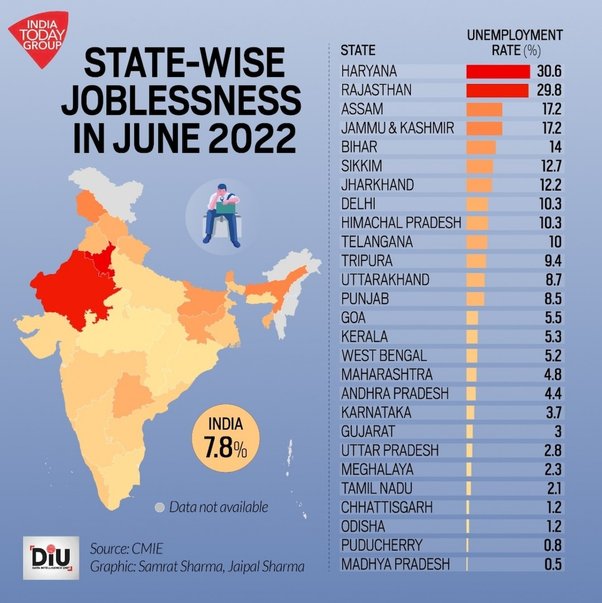Ahmedabad
(Head Office)Address : 506, 3rd EYE THREE (III), Opp. Induben Khakhrawala, Girish Cold Drink Cross Road, CG Road, Navrangpura, Ahmedabad, 380009.
Mobile : 8469231587 / 9586028957
Telephone : 079-40098991
E-mail: dics.upsc@gmail.com

Unemployment in India
Context: Recently a report, “State of Working India 2023” has highlighted the present status of unemployment in India.
Background:
• The report is prepared by Azim Premji University’s Centre for Sustainable Employment. It highlights the trends of Unemployment in India over the decade.
What are the key findings of the report?
• The overall unemployment rate has reduced to 6.6 per cent in 2021-22 from 8.7 per cent in 2017-18.
• Despite notable progress in various aspects of India’s labour market, the unemployment rate has reached a staggering 42% among graduates under 25 years old.
• Economic growth has not guaranteed employment in India. With every percentage increase in GDP, the capacity to generate formal sector jobs has systematically declined.
• While the workers have moved out of the agricultural sector, they have been absorbed in the informal and contractual employment as opposed to formal employment.
• Earning potential of women has decreased after the pandemic.
What is Unemployment?
• Unemployment refers to a situation where a person who is able and willing to work is not able to find a job.
What are the types of Unemployment?
• Cyclical Unemployment: This type of unemployment occurs during a recession or a period of negative economic growth. It is caused by the contraction phase of the business cycle, where the demand for goods and services falls dramatically, forcing businesses to lay off workers.
• Frictional Unemployment: This occurs when workers leave their old jobs but haven’t yet found new ones. It can also occur when students are looking for their first job or when mothers are returning to the workforce. Frictional unemployment is short-term and a natural part of the job search process.
• Structural Unemployment: Structural unemployment happens when there is a mismatch between the skills that workers in the economy can offer and the skills demanded by employers.
• Demand Deficient Unemployment: This type of unemployment occurs when there is not enough demand for all workers who want to work.
• Voluntary Unemployment: This refers to situations where individuals choose not to work at the prevailing wage rate.
• Technological unemployment: This occurs when technological advancements make certain jobs obsolete, leading to job losses in those sectors.
What are the reasons for High unemployment in India?
• The Degree oriented education system in India hasn’t helped employment perspective as it has failed to produce skilled human resources for specific job profiles that market needs.
• As educational attainment improves, more educated individuals are less inclined to accept unskilled and informal jobs. It is also one of the reason behind high unemployment among graduates.
• Workers generally avoid migrating to far-off areas of work due to factors like diversity of language, religion, customs and family loyalty. This low labor mobility has contributed to the high unemployment in India.
• Preference for Government jobs owing to status and social security it offers. Students chose to remain unemployed while preparing for government exams.
• Social security measures such as increased distribution of food under NFSA, PM Garib Kalyan Yojana and others has taken away the pressure on individuals to seek immediate employment which has contributed to increase in unemployment rate.
• Economic growth model of India has been tilted towards gig economy which is based on informal and contractual jobs. The workers have moved out of the agricultural sector however they have been absorbed in the informal and contractual employment.
• Decline of Small scale and cottage industries has resulted in higher unemployment in rural areas.
Need to address India’s Unemployment issue
• It is important from the perspective of reaping the Demographic dividend.
• When more women will become part of Labour force it will lead to socio-economic upliftment of women.
• Increasing formal employment and addressing the flaws in the informal sector jobs will help India alleviate poverty which will improve position of marginalized and vulnerable sections of India.
• High unemployment can lead to social unrest, increase regional disparity and exacerbate issue of inequality in the country.
What is the need of the hour?
• Focus on Skilling of labour force
• Special packages for Labour intensive industries – Leather, footwear, construction, food processing, textiles etc.
• Formulate National employment policy
• Implement New Education Policy 2020 in letter and spirit as it addresses several aspects – Skilling, vocational training etc.
• Promote women led SHG development. Take lessons from Kudumbashree program
• Government schemes such as Make in India, Skill India, Atma Nirbhar Bharat Rojgar Yojana (ABRY), Pradhan Mantri Rojgar Protsahan Yojana (PMRPY), MGNREGA etc. should be properly implemented for reducing the present levels of unemployment in India.

Address : 506, 3rd EYE THREE (III), Opp. Induben Khakhrawala, Girish Cold Drink Cross Road, CG Road, Navrangpura, Ahmedabad, 380009.
Mobile : 8469231587 / 9586028957
Telephone : 079-40098991
E-mail: dics.upsc@gmail.com
Address: A-306, The Landmark, Urjanagar-1, Opp. Spicy Street, Kudasan – Por Road, Kudasan, Gandhinagar – 382421
Mobile : 9723832444 / 9723932444
E-mail: dics.gnagar@gmail.com
Address: 2nd Floor, 9 Shivali Society, L&T Circle, opp. Ratri Bazar, Karelibaugh, Vadodara, 390018
Mobile : 9725692037 / 9725692054
E-mail: dics.vadodara@gmail.com
Address: 403, Raj Victoria, Opp. Pal Walkway, Near Galaxy Circle, Pal, Surat-394510
Mobile : 8401031583 / 8401031587
E-mail: dics.surat@gmail.com
Address: 303,305 K 158 Complex Above Magson, Sindhubhavan Road Ahmedabad-380059
Mobile : 9974751177 / 8469231587
E-mail: dicssbr@gmail.com
Address: 57/17, 2nd Floor, Old Rajinder Nagar Market, Bada Bazaar Marg, Delhi-60
Mobile : 9104830862 / 9104830865
E-mail: dics.newdelhi@gmail.com